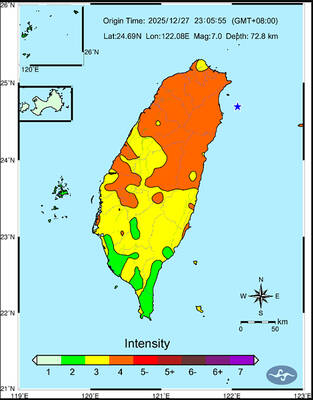Now there is one more place where cameras could start watching you — at 10,000m.
Newer seat-back entertainment systems on some airplanes operated by American Airlines and Singapore Airlines have cameras and it is likely they are also on planes used by other carriers.
American and Singapore both said on Friday that they have never activated the cameras and have no plans to use them.
However, companies that make the entertainment systems are installing cameras to offer future options such as seat-to-seat video conferencing, an American Airlines spokesman said.
A passenger on a Singapore flight last week posted a photograph of a seat-back display and the tweet was shared several hundred times.
The airlines said that they did not add the cameras — manufacturers embedded them in the entertainment systems.
American’s systems are made by Panasonic, while Singapore uses Panasonic and Thales, airline representatives said.
As they shrink, cameras are being built into more devices, including laptops and smartphones.
Seth Miller, a journalist who wrote about the issue in 2017, said that equipment makers probably did not consider the privacy implications.
There were already cameras on planes — although not so intrusive — and the companies assumed that passengers would trade their images for convenience, as they do with facial-recognition technology at immigration checkpoints, Miller said.
“Now they’re facing blowback from a small but vocal group questioning the value of the system that isn’t even active,” Miller said.
American Airlines spokesman Ross Feinstein said that cameras are in “premium economy” seats on 82 Boeing 777 and Airbus A330-200 jets.
“Cameras are a standard feature on many in-flight entertainment systems used by multiple airlines,” he said.
Singapore spokesman James Boyd said that cameras are on 84 Airbus A350s, Airbus A380s and Boeing 777s and 787s.
While the airlines say they have no plans to use the cameras, a Twitter user named Vitaly Kamluk, who snapped the photo of the camera on his Singapore flight, suggested that just to be sure, the carriers should slap stickers over the lenses.
“The cameras are probably not used now, but if they are wired, operational, bundled with mic, it’s a matter of one smart hack to use them on 84+ aircrafts and spy on passengers,” he tweeted.

A magnitude 7.0 earthquake struck off Yilan at 11:05pm yesterday, the Central Weather Administration (CWA) said. The epicenter was located at sea, about 32.3km east of Yilan County Hall, at a depth of 72.8km, CWA data showed There were no immediate reports of damage. The intensity of the quake, which gauges the actual effect of a seismic event, measured 4 in Yilan County area on Taiwan’s seven-tier intensity scale, the data showed. It measured 4 in other parts of eastern, northern and central Taiwan as well as Tainan, and 3 in Kaohsiung and Pingtung County, and 2 in Lienchiang and Penghu counties and 1

FOREIGN INTERFERENCE: Beijing would likely intensify public opinion warfare in next year’s local elections to prevent Lai from getting re-elected, the ‘Yomiuri Shimbun’ said Internal documents from a Chinese artificial intelligence (AI) company indicated that China has been using the technology to intervene in foreign elections, including propaganda targeting Taiwan’s local elections next year and presidential elections in 2028, a Japanese newspaper reported yesterday. The Institute of National Security of Vanderbilt University obtained nearly 400 pages of documents from GoLaxy, a company with ties to the Chinese government, and found evidence that it had apparently deployed sophisticated, AI-driven propaganda campaigns in Hong Kong and Taiwan to shape public opinion, the Yomiuri Shimbun reported. GoLaxy provides insights, situation analysis and public opinion-shaping technology by conducting network surveillance

‘POLITICAL GAME’: DPP lawmakers said the motion would not meet the legislative threshold needed, and accused the KMT and the TPP of trivializing the Constitution The Legislative Yuan yesterday approved a motion to initiate impeachment proceedings against President William Lai (賴清德), saying he had undermined Taiwan’s constitutional order and democracy. The motion was approved 61-50 by lawmakers from the main opposition Chinese Nationalist Party (KMT) and the smaller Taiwan People’s Party (TPP), who together hold a legislative majority. Under the motion, a roll call vote for impeachment would be held on May 19 next year, after various hearings are held and Lai is given the chance to defend himself. The move came after Lai on Monday last week did not promulgate an amendment passed by the legislature that

AFTERMATH: The Taipei City Government said it received 39 minor incident reports including gas leaks, water leaks and outages, and a damaged traffic signal A magnitude 7.0 earthquake struck off Taiwan’s northeastern coast late on Saturday, producing only two major aftershocks as of yesterday noon, the Central Weather Administration (CWA) said. The limited aftershocks contrast with last year’s major earthquake in Hualien County, as Saturday’s earthquake occurred at a greater depth in a subduction zone. Saturday’s earthquake struck at 11:05pm, with its hypocenter about 32.3km east of Yilan County Hall, at a depth of 72.8km. Shaking was felt in 17 administrative regions north of Tainan and in eastern Taiwan, reaching intensity level 4 on Taiwan’s seven-tier seismic scale, the CWA said. In Hualien, the